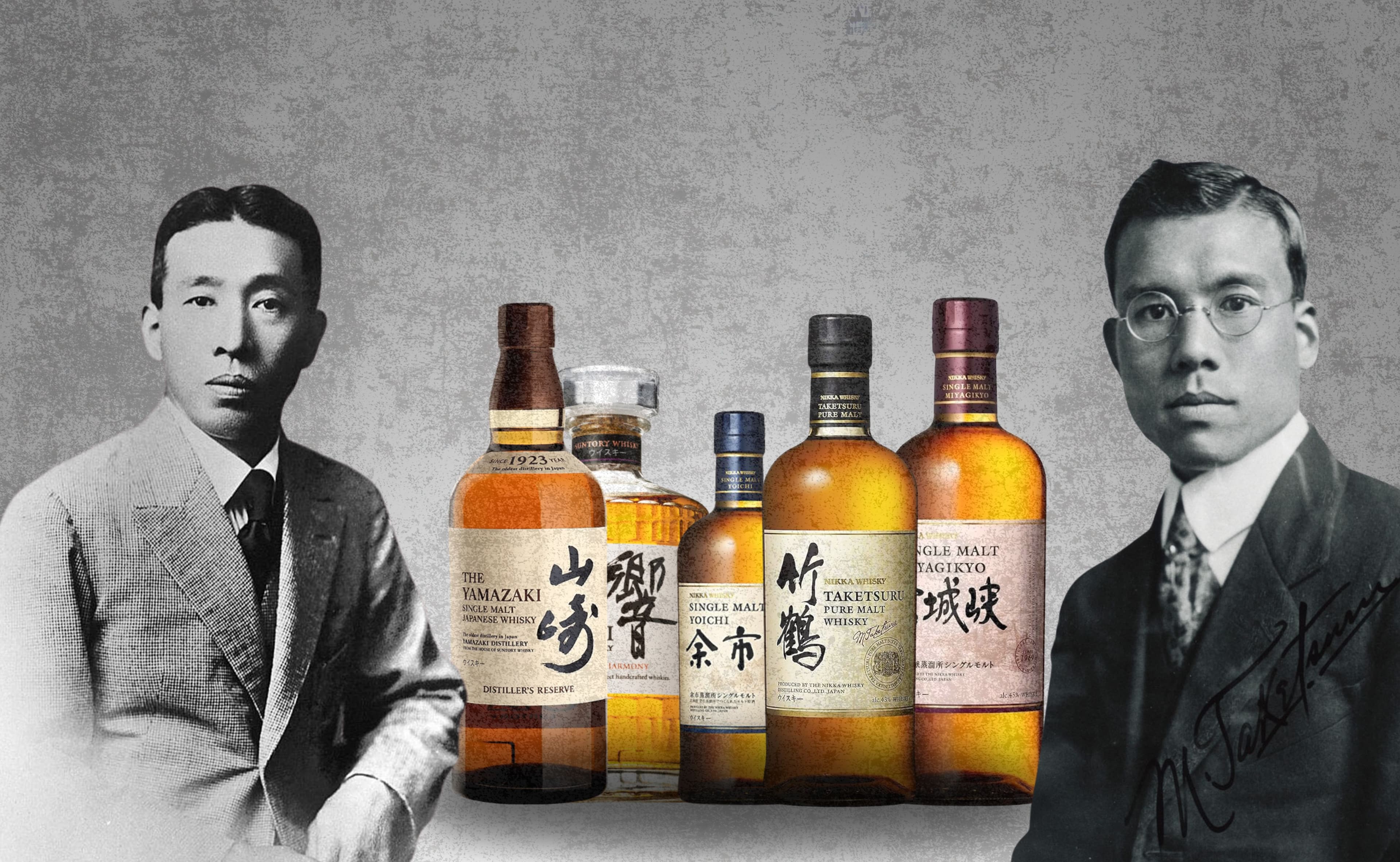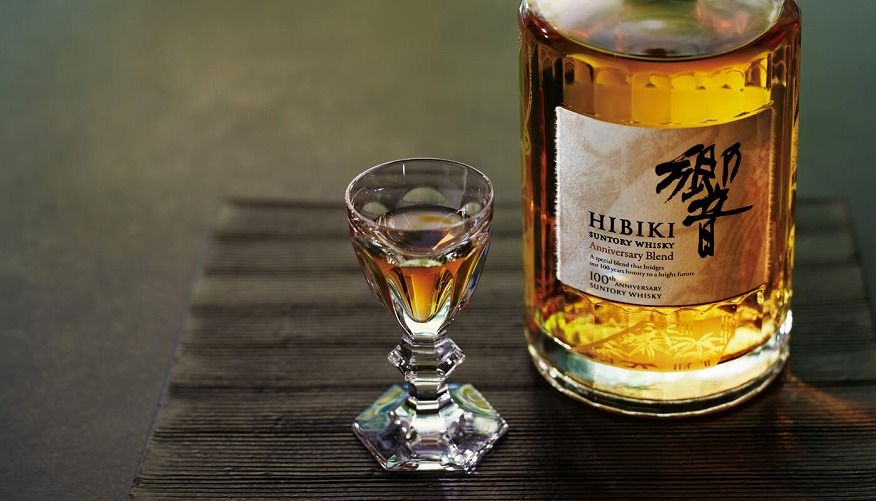15.05.2025
The Fathers of Japanese Whisky: The Vision of Masataka Taketsuru and Shinjiro Torii

The Fathers of Japanese Whisky: The Vision of Masataka Taketsuru and Shinjiro Torii
Japanese whisky today is celebrated for its elegance, precision, and often poetic approach to craftsmanship. Behind this global acclaim, however, lies a tale of vision, passion, and persistence. A story shaped primarily by two extraordinary men: Masataka Taketsuru and Shinjiro Torii. These pioneers, often referred to as the fathers of Japanese whisky, didn’t just create a product; they crafted a legacy.
The Birth of a Dream
The origins of Japanese whisky trace back to the early 20th century, a time when Japan was embracing Western culture with a mix of curiosity and reverence. Among those captivated by Western customs was Shinjiro Torii, a pharmaceutical wholesaler turned beverage entrepreneur. Born in Osaka in 1879, Torii had already made a name for himself by founding Kotobukiya (which would later become Suntory, one of the two major players in Japan's whisky and spirits industry) and introducing Western-style liqueurs and wines to the Japanese market. But his true ambition lay beyond. Torii dreamed of creating the first Japanese whisky.
However, there was only one problem: nobody in Japan knew how to make whisky. That’s when Masataka Taketsuru entered the story.
The Scottish Apprentice
Born in 1894 into a family of sake brewers in Hiroshima, Masataka Taketsuru was naturally drawn to fermentation and distillation. But while his family expected him to continue the sake business, Taketsuru looked West, to Scotland, the homeland of whisky.
In 1918, sponsored by Settsu Shuzo, a company with an eye on whisky production, Taketsuru set sail for Scotland. There, he enrolled at the University of Glasgow and apprenticed at several distilleries, including Longmorn, Bo’ness, and Hazelburn. He also married a Scottish woman,** Rita Cowan**, who would follow him to Japan and remain his steadfast partner through many hardships.
It was she who brought him to Campbeltown, where, at the Hazelburn distillery, he got hands-on experience in every stage of whisky making: from malting and mashing to fermentation, distillation, and aging.
More than a technician, Taketsuru became a true disciple of Scotch whisky. “Whisky-making is not simply a matter of technique,” he would later write in his notebook. “It is a way of life, a devotion to detail and patience.”
Taketsuru returned to Japan in 1920, whisky-making notebook in hand, but to a company that had lost interest in producing whisky, also due to the international crisis that followed the First World War. Luckily, destiny had other plans.
Taketsuru and Torii cross paths
When Sinjiro Torii learned of Taketsuru’s expertise, he saw in him the missing piece of his puzzle. In 1923, Torii hired Taketsuru to help design and build Japan’s first true whisky distillery: Yamazaki, located on the outskirts of Kyoto, Southern Japan. The location was carefully chosen by Torii for its pure water, temperate climate, and humid environment: ideal for aging whisky in oak casks. It also proved to be a winning choice from a logistical standpoint.
Taketsuru, with his deep understanding of Scottish techniques, was appointed factory director. The two men, though united in their love of whisky, often had clashing visions. Taketsuru favored a style closer to traditional Scotch: bold, peaty, and smoky. For this reason, he wanted to build the first distillery in the north of the country, where the climate was more similar to that of Japan, even if the region was more remote. While Torii insisted on creating a smoother, more refined whisky to appeal to Japanese tastes.
The Flop of the First Japanese Whisky
The first Japanese whisky, known as Suntory Shirofuda (White Label), was launched with high hopes but quickly became a commercial flop. Its bold, heavily inspired by Scottish styles, was unfamiliar and unappealing to Japanese palates at the time. It failed to capture the attention of consumers, and sales lagged far behind expectations. It was a tough start, but it laid the groundwork for Japan’s future whisky success. This disappointing outcome convinced Torii even more to seek a delicate, balanced flavour profile, one that would harmonize with Japanese cuisine and appeal to local tastes. A spirit crafted not as an imitation of Scotch.
“I wanted to make whisky that would suit the delicate taste of the Japanese people,” Torii once said. “I want to create original Japanese Spirits the whole world can enjoy, uniquely made from Japan’s nature and her people.”
The second Japanese whisky was Suntory Kakubin, launched in 1937. Unlike the first whisky, Suntory Kakubin became a huge success. This whisky, characterized by a softer profile more suited to Japanese tastes, represented a balance between Scottish tradition and local preferences. Its success played a crucial role in the growth and consolidation of the whisky market in Japan, helping Suntory become one of the country's leading distilleries.
A success that was also driven by the Kakubin Highball which became popular in Japan in the 1950s, largely due to the influence of American drinking culture. Suntory, aiming to promote whisky as an affordable and modern alternative to sake and beer, opened a series of bars called Tory's. These establishments introduced the whisky highball—a refreshing mix of whisky and soda water—as a new drinking style. This innovation was inspired by American bar culture, where whisky and soda were common choices. The highball trend resonated with Japanese consumers, aligning with their preference for drinking alcohol during meals. The addition of soda made whisky more approachable and easier to enjoy with food. Today, the Kakubin Highball remains a staple in Japanese drinking culture.

Two Paths, One Legacy
This creative tension between Taketsuru and Torii eventually led to a parting of ways. In 1934, Taketsuru left Yamazaki and moved north to Yoichi, Hokkaido—a rugged, remote area that reminded him of Scotland. There, he founded Dai Nippon Kaju (which would later become Nikka Whisky) and built the Yoichi Distillery, a facility designed to capture the soul of Scottish whisky with Japanese precision.
Taketsuru did express sentiments about Yoichi’s resemblance to Scotland. In his writings, he noted that the climate and scenery were similar to those of his time in Scotland, which helped his Scottish wife, Rita, feel at home. He described Yoichi as having the ideal conditions for whisky making, including the presence of peat and a suitable climate.
From these diverging paths, Yamazaki and Yoichi, emerged the two greatest pillars of Japanese whisky. Today, Suntory also owns two other distilleries: Chita (1972) and Hakushu (1973). Nikka, on the other hand, expanded by building the Miyagikyo Distillery in 1969, offering a lighter, more floral contrast to the robust character of Yoichi.
Despite the early challenges faced by both companies, the stories of Suntory and Nikka are tales of success, determination, and deep passion. Torii and Taketsuru were both driven by an almost spiritual dedication to their craft. They believed that whisky was not just a drink, but a bridge between cultures, a harmony of nature, science, and soul.
Global Recognition
For many years, Japanese whisky remained a domestic secret, enjoyed quietly by connoisseurs and only occasionally exported. That changed dramatically in the early 2000s, when Japanese expressions began winning international awards.
In 2001, Nikka’s Yoichi 10-Year-Old was named "Best of the Best" by Whisky Magazine. Later, in 2015, Suntory’s Yamazaki Sherry Cask 2013 was declared the “World’s Best Whisky” by Jim Murray’s Whisky Bible; while Hibiki 21 Years Old won “World’s Best Blended Whisky” in 2019 triggering a surge of global demand and cementing Japan’s reputation as a whisky powerhouse.

Pop culture also played a role in elevating Japanese whisky to international fame. The 2003 film Lost in Translation, directed by Sofia Coppola, featured Bill Murray filming a fictional ad for Suntory whisky with the now-iconic line “For relaxing times, make it Suntory time,” which sparked curiosity abroad. Back in Japan, the 2014 NHK morning drama Massan, based on the life of Masataka Taketsuru and Rita Cowan, brought the story of Japanese whisky’s origins to a wide domestic audience, further deepening appreciation for its heritage.
Today, Japanese whisky stands as a symbol of craftsmanship and cultural fusion. It marries Scottish tradition with Japanese subtlety, precision with poetry. And at the heart of this story are two men: Shinjiro Torii, the visionary businessman who dared to dream of a whisky made for Japan, and Masataka Taketsuru, the scientist, artist, and romantic who brought the knowledge and soul of Scotland to its shores.
Their legacy is not only found in the bottles we pour, but in the values that continue to guide Japanese whisky-making today: respect for nature, pursuit of harmony, and commitment to excellence.
About the author

Simone Sarchi
Italian journalist with a MA degree in International Journalism from City University of London. His love for whisky began with that very first sip of Laphroaig 10, which drew him into the world of peated malts and eventually led him to explore the endless variety of flavours and aromas this spirit has to offer. In recent years, he has combined his passion for whisky with his commitment to quality storytelling through his social media channels, driven by the belief that whisky is for everyone… you just have to find the right dram for your palate.
